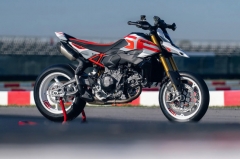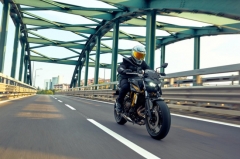Piaggio is working on tech to make you more visible to self-driving vehicles
In the future, radar reflectors could help your Vespa fare better against AI.

We are slowly moving closer to a world where self-driving cars are the norm. More and more new vehicles today are coming out of showrooms equipped with advanced driver assistance systems (ADAS) that make life easier for whoever's behind the wheel.
Eventually, the driver itself will be out of the equation, and only artificial intelligence (AI) will be left to manage our daily driving routines. While that could be some years away, one company is already working on technology to protect motorcyclists from autonomous vehicles. After all, bikes likely won't gain the same benefit from AI as cars will.
Piaggio, the Italian company behind Vespa, is reportedly developing low-cost active radar reflectors to make riders more visible to ADAS. Why radar? The detection system is one of the methods AIs use to help cars navigate by themselves. It enables features like adaptive cruise control, automatic emergency braking, blind-spot monitoring, and more.

Now, imagine cruising on your Vespa Primavera surrounded by a bunch of ADAS-equipped cars. You might think it would make the road generally safer, but that might not be completely true at the moment. In 2016, Dynamic Research Inc. came out with a study that showed ADAS in cars failed to recognize motorcycles in up to 40 percent of its tests.
That's troubling news, but it's reassuring that motorcycle manufacturers are already working to eliminate this safety risk. Piaggio now joins BMW and Suzuki in developing these active radar reflectors. Piaggio's solution involves a more advanced approach that borrows from technology seen in large boats. By shrinking the tech significantly, Piaggio hopes to emulate the way ships avoid smaller boats at sea.
The miniaturized technology includes a receiving antenna, a transmitting antenna, an amplifier, and a control chip. These components could easily fit somewhere the rider will never see it. Piaggio suggests putting one in the headlight and another in the taillight. That way, the rider gets 360-degrees of protection.
How it works is it receives the radar signal from a vehicle, amplifies it, then transmits it back to the sender as a unique signal. Piaggio has also claimed that the tech could include other details on the transmitted signal, including the motorcycle's speed, the direction of travel, acceleration, and braking.
That sounds like an ingenious solution, and the best part is it may not even cost that much to produce due to its relatively basic components. So, as we get closer to a driverless future, it's highly likely we see Vespas equipped with this radar safeguard. Ultimately, if it makes riders safer on the road, we're all for it.
Tagged Under
Related Articles
-
Vespa updates the Primavera and Sprint S ahead of its 80th anniversary / News
New brakes, wheels, electronics, and a special Verde Pastello series lead the brand into 2026.
-
Feast your eyes on the 2023 Vespa Primavera Color Vibe series / News
Vespa has revealed its 2023 Primavera Color Vibe series scooters in the global market. The vibrant colorways are sure to be a hit in the local market.
-
Honda is reportedly working on a motorcycle autopilot system / News
Could Honda change the game with an autonomous riding system for motorcycles?
-
Vespa releases limited edition Primavera (RED) 125 in Japan / News
The Primavera (RED) 125 has been released in Japan by Vespa and (RED). Each purchase of the limited-edition scooter will result in a $100 donation to the International Insurance Fund for 500...
-
The Kawasaki Ninja H2 SX might be getting a camera system soon / News
New patent applications show a Ninja H2 SX with a camera-system that could augment the existing radar system.
Latest News
-
Take a look at the new Honda CB1000F / News
Honda has revealed the production-spec CB1000F, blending retro style with Hornet-based performance and modern tech. Expected to hit UK showrooms in early 2026.
-
Ducati launches all-new Hypermotard V2 with cutting-edge tech / News
The Hypermotard V2 keeps its aggressive stance and signature beak while bringing sharper design and modern electronics.
-
2026 Kawasaki Z650 S gets more aggressive styling and premium tech / News
The 2026 Kawasaki Z650 S adds new styling, updated tech, and the same dependable 649cc engine loved by middleweight riders worldwide.








